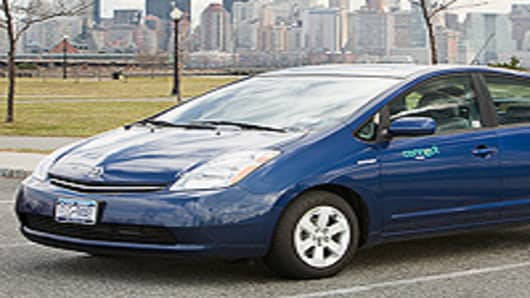Between 2007 and 2008, car sharing membership increased 51.5 percent in the United States, according to Susan Shaheen, researcher and co-director of the Transportation Sustainability Research Center at the University of California, Berkeley.
“It’s still growing,” Shaheen added, “I don’t see this slowing down.”
New entrants to the field include car rental companies Hertz and Enterprise; and more recently from automaker Daimler.
"It’s another validation of what we’ve been saying for a while," says Scott Griffith, chairman and CEO of Zipcar. "We’ve been seeing the growth of this category and that is what's driving these new entrants."
Car sharing gives consumers access to a car whenever they want without having to deal with the responsibility of owning or renting one. Most services are found in larger cities, where most residents use public transportation.
How It Works
Members pay a yearly membership fee (typically around $50). Users book a vehicle online or through a smartphone application and pay for the car on an hourly or daily rate, usually around $9 an hour or around $70 dollars for the day. Insurance and fuel costs are included in the price, and maintenance and cleaning is taken care of too.
Vehicles are parked in garages and members are told where to pick up the car. They use an electronic card—recevied at the time of membership—to unlock the vehicle. You can take the car anywhere, but have to bring it back to where it was picked up.
The newest company to enter the market, Daimler's car2go unit, which is being tested with 13,000 city workers in Austin, Texas, is changing the formula a little bit.
Instead of having to bring a car back to a designated parking area, members can park the car anywhere within the parameters of Daimler’s network.
If it works, the car2go model could be a game changer for the industry because it gives the customer more options in terms of how much they spend on renting a car. Theoretically, customers using car2go can drive to the movie theater, for example, and pay for the drive and then end the rental while they are watching the movie, an option that other car sharing companies don’t have. With a traditional car share, members would have to pay for the time spent watching the movie too.
Experts say that mapping out the logistics of the plan is complicated, as bike-sharing companies in Europe have shown, but industry leaders are watching to see how the automaker does in Austin.
Daimler has over 200 Smart Fortwo cars available to city workers now, but plans to expand the service for general use in the city in late 2010.
After a successful pilot in Ulm, Germany, Daimler decided to launch its first test in the Texas capital because of the “influx of people moving into their downtown area,” among other reasons, said Nicholas Cole, president and CEO of car2go North America.
The city has what the company was looking for—a mix of working professionals, residents, government workers and college students.
The college-student demographic has become increasingly important to car sharing companies. College students are viewed as future customers since they are more likely to move to larger cities after graduating, where these companies are already based. As a result, companies are operating in more college campuses.
“It’s a growth sector and it’s an untapped market,” says Griff Long, senior director of Connect by Hertz, which has fleets on some 20 campuses. “Many universities don’t allow freshman and sophmores to park on campus, so this enhances the student experience, and it helps the school to save money by avoiding building expensive parking garages.”
ZipCar has a strong presence at institutions around the country and can be found in over 140 campuses around the country.



